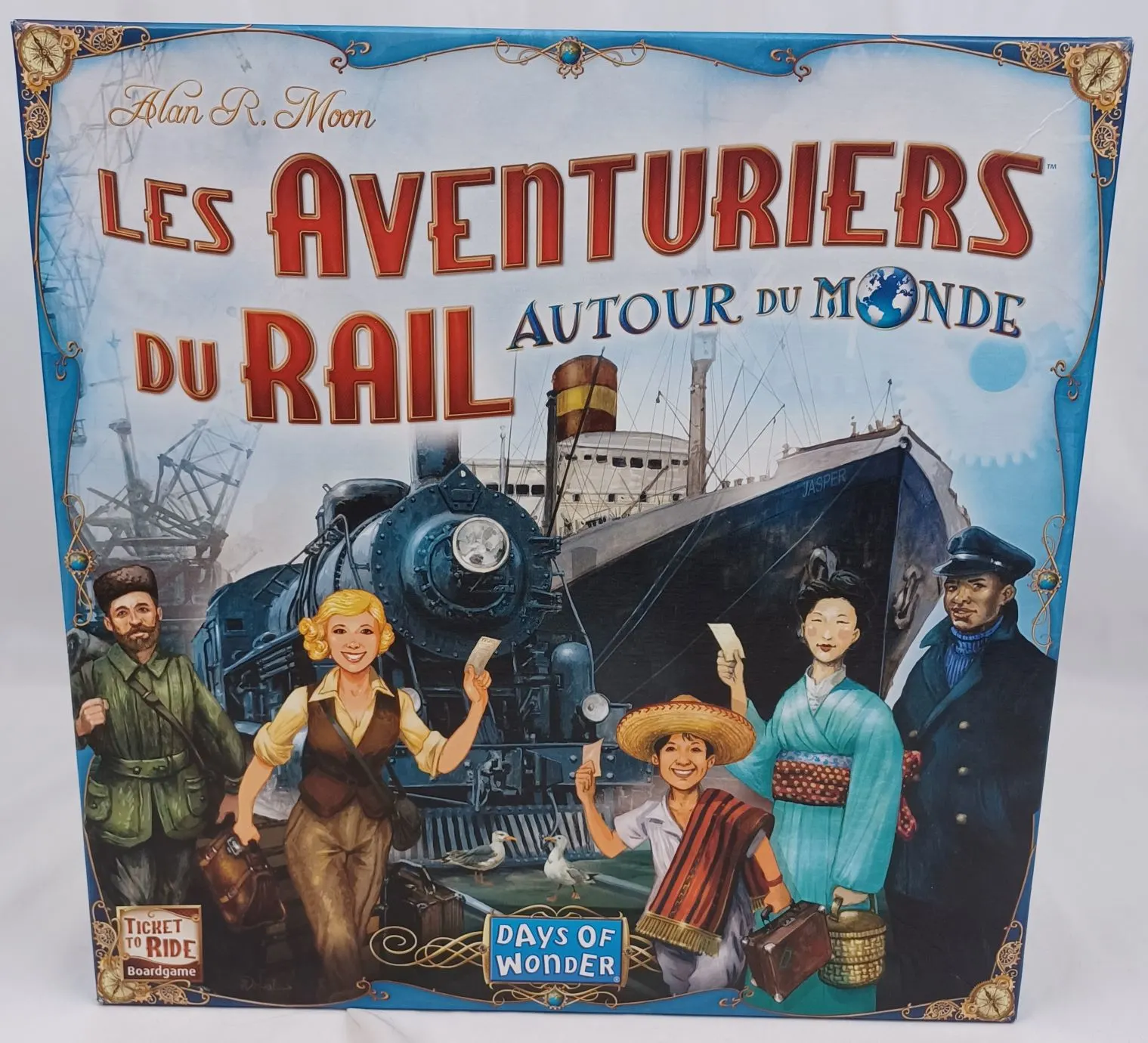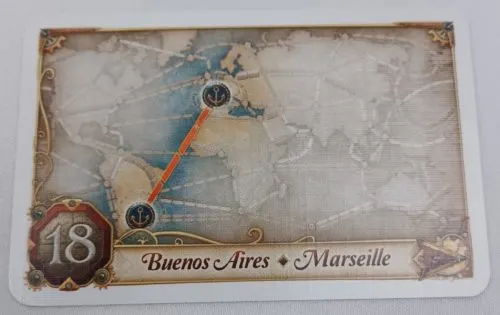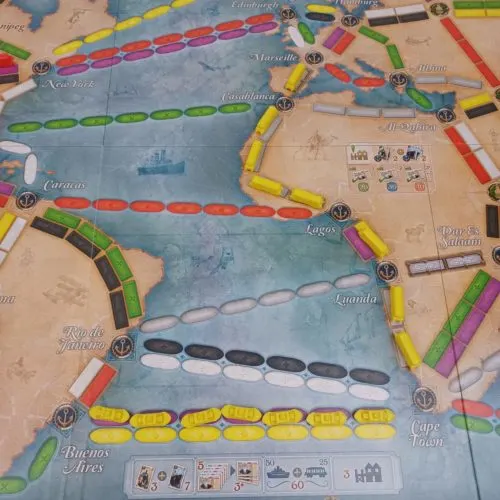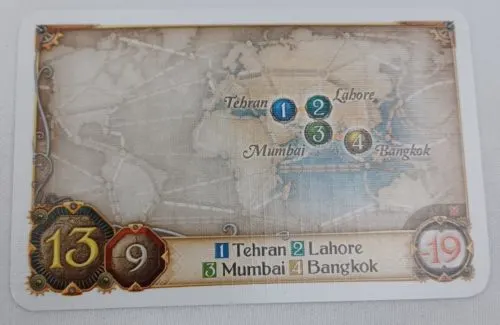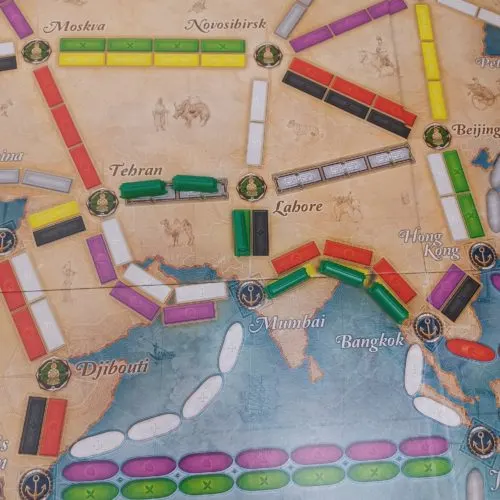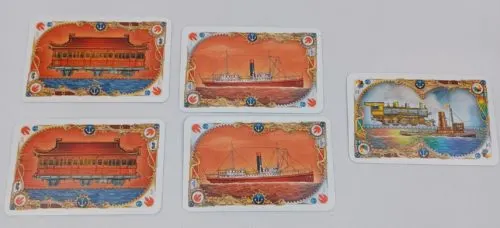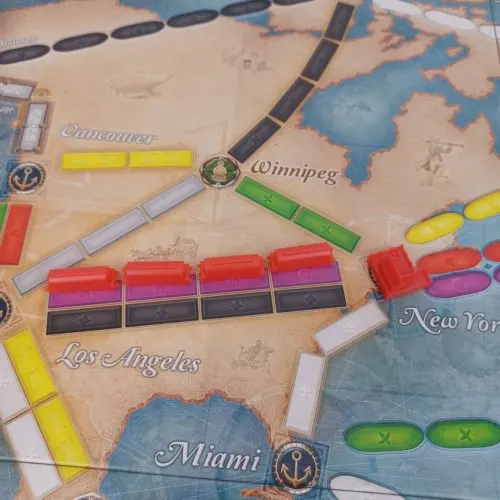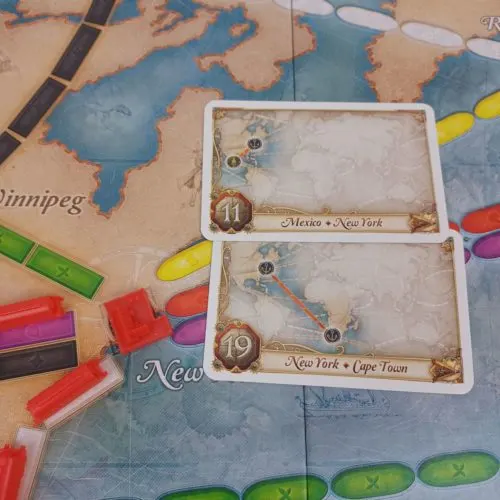Any regular readers of Geeky Hobbies will know that my favorite board game of all time is the original Ticket to Ride. The game is honestly the closest thing to a perfect game that I have ever played. I think this is due to the fact that the game has the perfect balance between simplicity and strategy. The game is easy enough that almost anyone can play it, and yet the game has enough strategy where it feels like your decisions truly matter. What you get is a compelling game that I would play whenever I got the opportunity. Because of how much I love the original game, I have checked out a number of the Ticket to Ride spinoff games including Ticket to Ride Card Game, Ticket to Ride Europe, Ticket to Ride First Journey, and Ticket to Ride Marklin. I had high expectations heading into Ticket to Ride Rails & Sails as it is considered the “advanced” Ticket to Ride and the idea of having both train and ship routes intrigued me. Ticket to Ride Rails & Sails takes the original game and tweaks it into a more advanced game creating a game that might arguably be better than the original.
How to Play Ticket to Ride Rails & Sails
Ticket to Ride Rails & Sails shares a lot of mechanics in common with the original game so I have streamlined these rules more than usual. I have also combined the rules for both The World and Great Lakes maps, and have noted the rules that only apply to one of the maps.
Setup
- Place the game board in the middle of the table.
- Shuffle the train and ship cards separately.
- Deal train and ship cards to each player depending on which map you are playing.
- For The World map each player is dealt three train and seven ship cards.
- For The Great Lakes map each player is dealt two train and two ship cards.
- Flip the top three cards from the train and ship decks face up on the table. The rest of the cards form the two draw piles.
- Shuffle the ticket cards and deal five to each player. Each player will look at their tickets and choose which they would like to keep. Each player must keep at least three of their tickets, but may keep four or all five. Any tickets that players don’t want are returned to the bottom of the deck.
- Each player will be given a number of plastic trains and ships depending on which map is played. They will then choose which combination of trains and ships they will keep. Players will reveal how many trains and ships they kept at the same time. The rest will be set off to the side.
- The World – Each player will be given 25 trains and 50 ships. They will get to keep a total of 60 plastic pieces. For your first game the instructions recommend keeping 20 trains and 40 ships.
- Great Lakes – Each player will be given 33 trains and 32 ships. They will get to keep a total of 50 plastic pieces. For your first game the instructions recommend keeping 27 trains and 23 ships.
- Each player takes three harbors. Each player will place their chosen color scoring token on the zero space of the scoring track.
- The player that has traveled the most goes first. Play will proceed clockwise throughout the game.
Playing the Game
On your turn you can choose one of five actions to perform on your turn.
- Take Travel Cards
- Claim A Route
- Draw Tickets
- Build a Harbor
- Exchange Pieces
Take Travel Cards
When you choose this action you will have the opportunity to add up to two cards to your hand. Unlike the normal Ticket to Ride, this version of the game includes train and ship cards. Train cards are used to claim land routes and ship cards are used to claim water routes.
When choosing cards you can either choose one of the six face up cards or the top card from either of the draw piles. You can even take one face up card and one face down card.
If a player takes a face up card, they will replace it with the top card from one of the draw piles. The player taking the card gets to choose whether it is replaced with a train or ship card. Because of this the number of face up train and ship cards can change throughout the game.
If a player chooses a face up wild card, that is the only card they will get to take on their turn. If a player gets a wild from taking the top card from the draw pile, they will still get to take another card. If at any time three of the six face up cards are wilds, all six face up cards are discarded and replaced with three cards of each type.
If a draw deck runs out of cards, shuffled the corresponding discard pile to form a new draw pile.
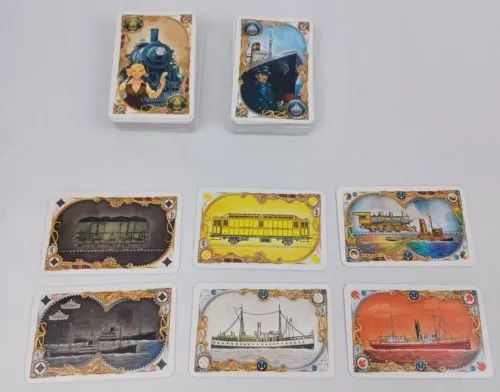
This player has chosen to take travel cards. They can choose any of the face up cards, or the top card from one of the face down decks. If the player chooses the wild card in the top right corner, they will only get to take one card.
Claim A Route
For your turn you can choose to claim one of the routes on the game board. You can claim any open route even if it isn’t connected to routes you have already claimed. To claim a route you must play the corresponding number of cards that match the color of the route you want to take. The cards must also match the correct type of transportation (trains for land, ships for water). Once a route has been claimed, no other player may claim it for the rest of the game. The one exception to this is that some routes feature two sets of tracks. If you are playing with four or five players, a different player can claim the second route by playing the corresponding colored cards. Wild cards can act as any other colored train or ship card.
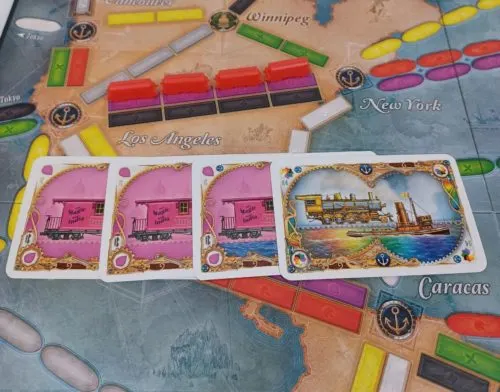
This player played three pink trains and a wild. As they played four pink trains, they have claimed the route between Los Angeles and New York.
Great Lakes – Some cities will have both a train and ship route that connects the same two cities. These do no count as double routes so both can be claimed in games with any number of players.
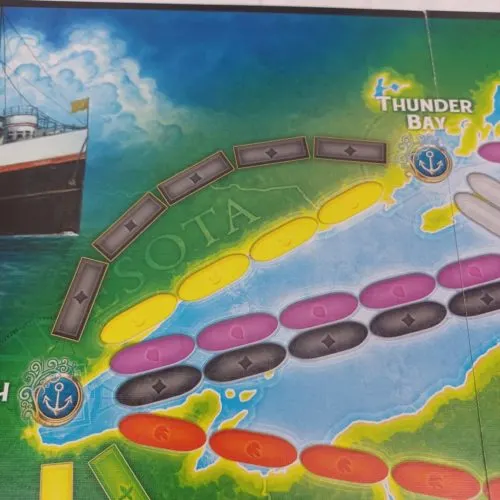
There is both a train and boat route between Duluth and Thunder Bay. When one of these routes is claimed, the other can still be claimed even in two and three player games.
If a route features gray spaces, you can use cards of any color, but all of the cards must be the same color.
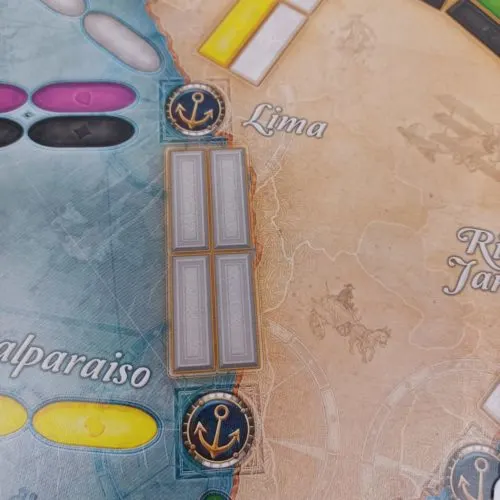
Between these two cities are two gray spaces. To claim this route you have to play two train cards of the same color.
When playing ship cards some of the cards feature two ships. These count as two ships. You can overpay by using double ship cards to claim a route.
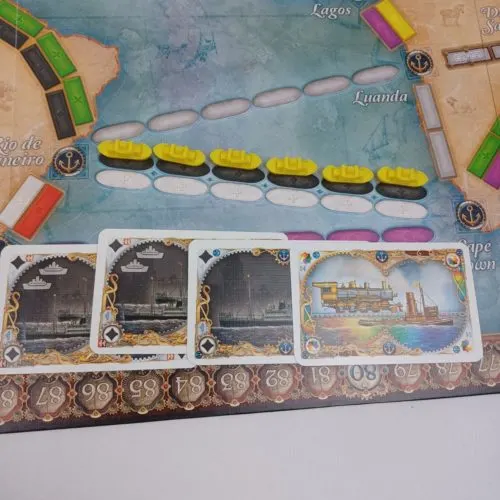
This player has played two double ship cards as well as a wild and a single black ship card. As they played a total of six black ships, they have claimed the black route.
Once a player claims a route they will put the corresponding number of plastic trains/ships on the spaces of the route they claimed. You must use the correct plastic pieces for the route you claim. You will then move your scoring marker forward spaces equal to the length of the route you claimed referencing the chart printed on the board.
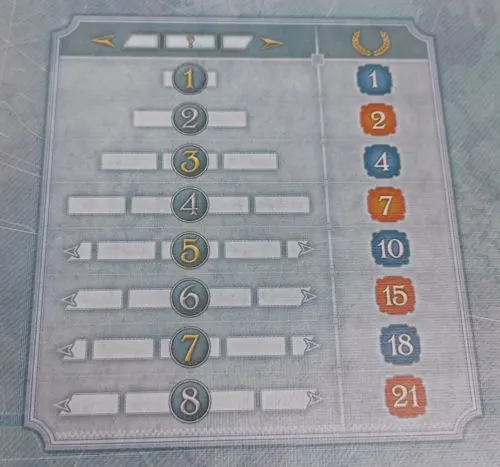
Here is the chart for scoring the various lengths of routes. For example if a player claims a five train/ship route, they will score ten points.
World Map – The World Map has a couple routes which are marked by the “Pair” symbol. To claim this route you need to play two train cards of the same color for each space featuring the symbol. This color may be different than those used for the rest of the route.
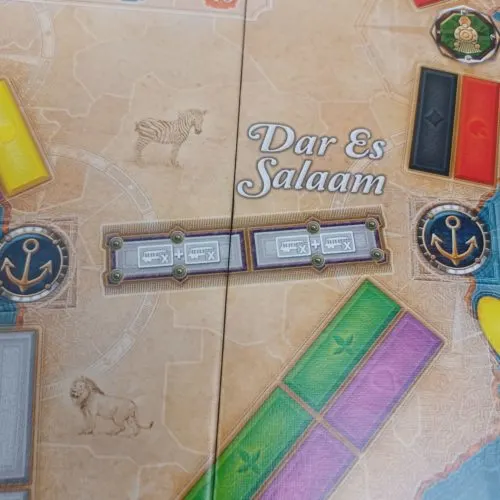
This route features two spaces that have the pair symbol. You will have to play two pairs of train cards of the same color to claim this route.
Drawing Tickets
For this action you will draw the top four cards from the ticket deck. If there are less than four tickets remaining, you will only get as many tickets as there are still remaining.
After drawing tickets the player has to keep at least one of the tickets. They can choose to keep two, three or all four cards if they want though. Any cards that the player doesn’t want can be added to the bottom of the deck. Once a player decides to keep a ticket though, they must keep it for the rest of the game.
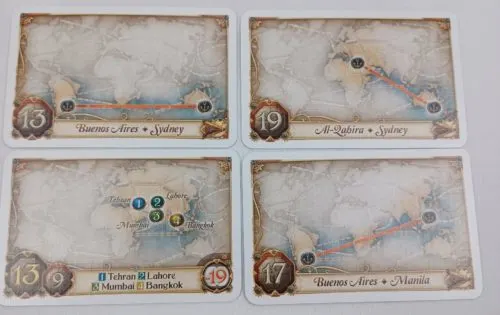
This player has chosen to take new tickets. They will have to keep at least one of these four tickets. They can choose to keep as many of the cards as they want though.
Each of the tickets feature two cities. The goal is to claim a set of routes that connect the two cities featured on the ticket card. If you complete the connection you will score the points shown on the card at the end of the game. If you fail to complete the connection, you will lose the points shown on the card. Players can keep as many tickets as they want throughout the game, but once a ticket is taken the player cannot get rid of it. They should not show the other players their tickets until the end of the game.
- For this ticket the player has to connect Buenos Aires to Marseille. If they connect the two cities they will score 18 points. If they fail to complete the ticket they will lose 18 points.
- This player has connected Buenos Aires and Marseille. Since they have completed the ticket they will earn 18 points.
World Map – The right and left sides of the board are connected to one another based on the arrows shown on the sides of the board.
World Map – Tour ticket cards are exclusive to the World Map. These tickets will show more than two cities. If a player is able to connect the shown cities in the order shown on the card they will score points equal to the higher number in the bottom left corner. If they connect the cities but not in the right order, they will score points equal to the lower number in the bottom left corner. If they fail to complete the ticket, they will lose points equal to the number in the bottom right corner.
- This tour ticket requires the player to connect Tehran, Lahore, Mumbai, and Bangkok. If they connect the cities in that order they will score thirteen points. If they connect the cities but not in that order, they will score nine points. If they don’t complete the ticket they will lose 19 points.
- This player connected Tehran to Lahore, Lahore to Mumbai, and finally Mumbai to Bangkok. As they have completed the ticket in order, they will score thirteen points from the ticket.
Build A Harbor
Harbors can only be built in cities that feature an anchor symbol. Each city can only have one harbor built on them. To place a harbor in a city, you must have claimed at least one of the routes that connect to that city.
To build a harbor you must discard two train and ship cards that are all the same color and feature the harbor symbol (anchor) on them. Wild cards can be used to replace any of these four cards.
- Pictured are two trains and two ship cards that feature the anchor symbol. A player needs all four of these cards in order to place a harbor. If they were missing one of these cards, they could replace one of them with the wild card on the right.
- This player has placed a harbor in New York.
At the end of the game players will score points for their harbors based on how many tickets they have completed that feature the city that a harbor was placed in. The amount of points rewarded depends on which map you are playing:
- World Map
- 20 points if a harbor is featured on one completed ticket
- 30 points if a harbor is featured on two completed tickets
- 40 points if the harbor is featured on three or more completed tickets
- Great Lakes
- 10 points if a harbor is featured on one completed ticket
- 20 points if a harbor is featured on two completed tickets
- 30 points if a harbor is featured on three completed tickets
Any harbor that a player fails to place during the game will lose the player four points at the end of the game.
Exchange Pieces
If at any time a player needs more plastic trains or ships they can use a turn to exchange ships for trains or vice versa. When you choose this action you can exchange as many pieces as you want, but you will lose one point for each piece that you exchange.

This player has decided to exchange two trains for two ships. They will lose two points for making the exchange.
End of Game
Once one player has six or less plastic pieces that they haven’t played yet, the game enters the end game. Each player including the player with six or less pieces left will get two more turns. The game will then end.
Players will score points as follows:
- Points earned throughout the game.
- They will score additional points for each completed ticket and lose points for any tickets they didn’t complete.
- Players will score points for completed tickets into their harbors.
- Players will lose four points for each harbor they didn’t place.
The player with the most points wins the game.
My Thoughts on Ticket to Ride Rails & Sails
With Ticket to Ride being my favorite board game of all time, I had high expectations for Ticket to Ride Rails & Sails. Despite this Ticket to Ride Rails & Sails lived up to my expectations and might have actually surpassed them. I don’t know if I am ready to say that it is a superior game to the original, but it is comparable at least.
As I have reviewed a number of other Ticket to Ride games over the years, I am not going to go into much detail on my thoughts on the basic gameplay as it remains mostly the same. The gameplay still mostly revolves around acquiring train/ship cards of the same color in order to acquire routes. You acquire these routes to complete tickets in order to score points. The player that scores the most points wins the game. If you have ever played one of the other Ticket to Ride games, you probably already have the gist of 80% of the game.
What I love about the Ticket to Ride formula is that it has the perfect balance between simplicity and strategy. There are easier games out there, but after a short introduction the game is straightforward enough that it is quite easy to play. The game is more complicated than your typical mainstream game and has a recommended age of 10+, but it is still quite easy to play. The game can be taught in maybe 10-15 minutes and after a couple turns players should have a good grasp on what they are trying to do. A sign of a good game in my opinion is that it was made no more difficult to play than it had to be. Ticket to Ride is the perfect example of this.
Despite being easy to play, I think the game has quite a bit of strategy as well. There are obviously games that are more strategic, but it is has quite a bit of strategy based on its difficulty level. The game at its core is a set collecting game as you try to acquire cards of the same color so you can acquire routes. The game has quite a bit of strategy though as you try to find the best set of routes to complete your tickets and score points. A lot of the strategy comes from finding a way to complete as many of your tickets as possible while limiting the number of routes you have to claim. When someone claims a route that you need you also need to adapt to find a different path. The game can get tense especially when you are close to completing a ticket and just need one or two turns to get everything that you need to finish the path between two cities. The gameplay is just so straightforward and satisfying that I have played around 1,000 different board games, and the original game still retains the spot as my favorite board game of all time. All of my feeling towards the original game apply to Ticket to Ride Rails & Sails as well.
Many people consider Ticket to Ride Rails & Sails as a more advanced version of the original game and I can see the comparison. On the surface the game is very similar to the original game, but I would say that it is a more advanced version of the game. The new mechanics don’t make the game considerably more complex, but they do add additional strategy to the game where I would say that it is the definitive version of the game if you are looking for more strategy. Everything about the game seems larger from a bigger board to more cards and even more ways to score points.
I can see this being both a positive for some players and a negative for others. People who like the idea of Ticket to Ride but wish it had more strategy will likely love the additional strategy as it does give you more decision making in the game. There are more potential strategy options that you can pursue, and there are more things to consider on each turn. On the negative side this does make the game a little less accessible. I would honestly recommend playing the original game with new players before jumping right into Ticket to Ride Rails & Sails. The game is still pretty easy to play, but it does require a little more than the original game.
For the most part Ticket to Ride Rails & Sails adds two main new mechanics while also adapting a few other mechanics from some of the expansions released after the original game. The two main differences are the addition of ships as well as harbors.
Ships are easily the biggest addition to the game. In a lot of ways the ship routes act the same as train rails, but the fact that there are two different modes of transportation does change up the gameplay quite a bit. You have to maintain cards for both types of transportation which means you will have to spend more turns drawing cards. Your hand of cards is going to get quite a bit larger as well. In addition to having the right colors to claim a route, you also need to get them in the right mode of transportation. Having two modes of transportation regularly gives you more options to create connections between cities.
I really liked the addition of ships to the game for a number of reasons. The fact that they give you more options is always welcome. At the beginning of the game you have to sort of decide whether you are going to go more towards train or water routes as you decide how many ships and trains you will start with. You can always trade one type for another, but that will cost you points and a turn so it isn’t advised if possible. While it might not seem like much at first, the idea of two different modes of transportation really changes how you approach the game. I don’t know if any other Ticket to Ride games have implemented ships since, but I hope they do as they add interesting new decisions to the game. For example whenever you draw a face up train or ship card you get to choose what card will get turned face up. If you know the other players are favoring one of them, you could purposely put out the other to make it harder for them to get what they want.
The other main addition to Ticket to Ride Rails & Sails is harbors. Harbors add an interesting new way of scoring points to the game. If possible you want to place your harbors as you lose points if you don’t. Harbors can be a huge source of points if you use them correctly. Typically one of the best ways to score a lot of points in Ticket to Ride is to get a bunch of tickets in the same general area as you are then able to use your claimed routes for several different tickets. This is enhanced further by the harbors as you are rewarded for having multiple tickets that start or end in the same city. If you have multiple tickets featuring the same city you need to try and get a harbor in that city as it will score you a lot of points.
While lucrative, it is pretty hard to place harbors in the game. That is because you need cards that feature the harbor symbol as well as cards that are the same color. There are only four cards of each train/ship for each color that feature the symbol. Wilds can also be used for harbors though making them considerably more valuable. To place a harbor it is usually something that you have to actively pursue as the opportunity to place one usually doesn’t fall into your lap. You need to dedicate turns to placing a harbor instead of acquiring routes. If you can get a harbor into a valuable city though it is well worth it as it can make you plenty of points.
Like the addition of ships, I like harbors. Harbors might not play a huge role in some games, but they give you another option for scoring points in the game. The risk versus reward for them seem to be about right as well. It is not easy to place them, but if you can get them in the right spot they can score you a lot of points. I almost always appreciate when games give players more ways to score points as it gives you more things to play with when creating your strategy. The harbors are a nice addition to the game as they don’t distract from the rest of the game, while also giving players the option of a pretty powerful tool to use in their strategy.
As I mentioned earlier Ticket to Ride Rails & Sails is basically a bigger version of the original game in almost every way. The game gives you more options and thus leads to the games taking longer. I wouldn’t say the game gets overly long, but outside of rare occasions it will take longer than the original game. Between this and the additional strategy, Ticket to Ride Rails & Sails is not as streamlined as the original game. Some people will prefer this, but others will prefer the simpler more streamlined original game. This is the main reason why I can’t say that Ticket to Ride Rails & Sails is better or worse than the original game. Some people will prefer both games. I can see the merits in both games and thus will likely play both games around the same amount.
Before wrapping up I wanted to quickly talk about the game’s components. Like pretty much every version of Ticket to Ride, the components are great for Ticket to Ride Rails & Sails. The first standout for the components is the fact that the game actually includes two different maps. While the two maps aren’t drastically different, I loved the addition. The two maps are different enough that they provide quite a bit more replay value to the game. The World map seems more spread out and features more ship routes, while the Great Lakes is more compact and has more train routes. I think both maps are worth playing. The game’s artwork is great like the rest of the series. The game also contains the same quality plastic trains as well as ships. The component quality is really on par with the rest of the games in the series.
I really only had two complaints with the components. First the game is quite a bit larger than the original in both the size of the box and how much space it takes up when playing. You will need a full sized table to play the game as the map is really large. The other issue is that the game is more expensive than the original game. This is most likely due to the additional components that the game comes with. The game had an original MSRP of $80 which is pretty expensive. That is part of the reason why it took some time for me to pick up the game. I ended up finding a French version of the game though for cheap which explains why the box in the pictures for this review are not the English version of the game. Just for reference you actually don’t need to purchase your language version of the game as outside of the box and the instructions everything else in the game in language independent. You will just need to print the correct instructions off the Days of Wonder website.
Should You Buy Ticket to Ride Rails & Sails?
I had high hopes for Ticket to Ride Rails & Sails due to my love of the franchise and the premise that it would be an advanced version of Ticket to Ride. Despite these high expectations, I actually think Ticket to Ride Rails & Sails lived up to them. I don’t know if I would say that it is for sure better than the original, but it is on par with it for sure. The game maintains the perfect balance between simplicity and strategy of the original game, while also adding in some interesting new mechanics. I would say the game is more strategic than the original game. The addition of the ships and harbors add a lot to the game and are great additions in my opinion. Basically the game has everything that fans of the series could want from a more advanced version of Ticket to Ride.
If you have never really cared for Ticket to Ride or aren’t particularly interested in a little more advanced version of the game, I don’t think Ticket to Ride Rails & Sails will be for you. Fans of the series though should love the game especially if you are intrigued by a game with a little more strategy. I would highly recommend any fans of Ticket to Ride to at least consider picking up Ticket to Ride Rails & Sails.
Buy Ticket to Ride Rails & Sails online: Amazon, eBay
. Any purchases made through these links (including other products) help keep Geeky Hobbies running. Thank you for your support.

